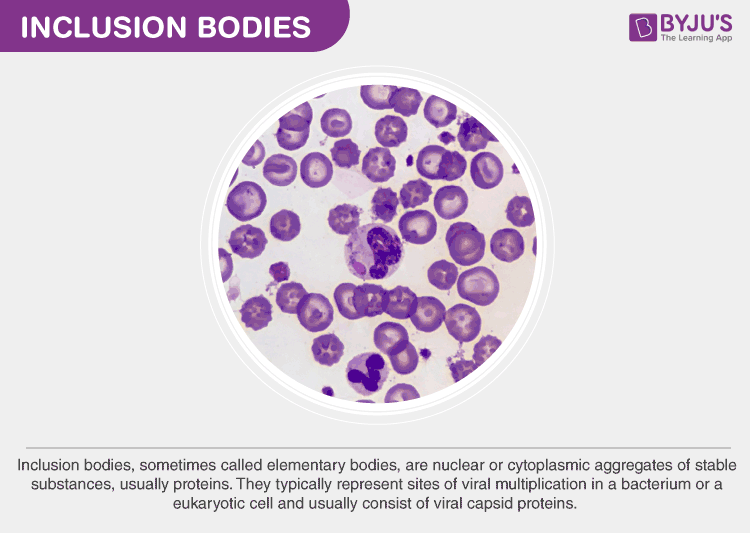Table of Contents
General Features of Inclusion Bodies
Classification of Inclusion Bodies
The cell is the smallest, fundamental unit of all living organisms. Every living organism is composed of one or more cells, and therefore it is referred to as the building blocks of life. There are different types of cells- blood cells, nerve cells, and muscle cells and are involved with their specific functions. The main features of these cells are they provide shape and carry out specialised functions.
There are many cell organelles, which are membrane-bound and perform a specialised function to keep the cell alive and active. Among these, few cell inclusions serve as the reserve materials in prokaryotic cells and are present within the cytoplasm of the cell.
Let’s learn more about the Inclusion bodies along with the general features and their classifications.
Also Read: Cells
What are Inclusion Bodies?
The inclusion bodies are tiny particles found freely suspended and floating within the cytoplasmic matrix. Therefore, also referred to as cytoplasmic inclusions. These cell inclusions are formed with decreasing pH and from the pool of soluble fusion proteins within the cell. They are the elementary bodies, formed during infectious diseases or within the virus-infected cells such as rabies, herpes, measles, etc.

Inclusion bodies are abnormal structures with distinct sizes and shapes and are usually observed in nerve, epithelial, or endothelial cells. They have a characteristic staining property and are typically composed of proteins.
Inclusion bodies are non-living chemical compounds and by-products of cellular metabolism. They are found both in prokaryotes and eukaryotes. There are a wide variety of inclusion bodies in different types of cells. In prokaryotic cells, they are mainly formed to store reserve materials. In animal cells, they store fats and sugars that are ready for cellular respiration and in plant cells, they store granules of materials like glycogen, starch, etc.
Gas vacuoles, cyanophycean granules, phosphate granules, and glycogen granules are a few examples of inclusion particles.
General Features of Inclusion Bodies
-
They are generally acidophilic.
-
Maybe crystalline aggregates of virions.
-
Represent degenerative changes produced by a viral infection.
-
Are made of virus antigens present at the site of virus synthesis.
-
They are seen as pink structures when stained with gypsum or methylene blue dye.
Also Read: Cytopathic Effect
Classification of Inclusion Bodies
Inclusion bodies can be classified into different types based on their location, either at the nucleus or cytoplasm or at both the cell organelles. The different types of inclusion bodies are as follows:
- Intranuclear inclusions.
- Infection inclusion bodies.
- Intracytoplasmic inclusions.
- Physiological inclusion of bodies.
Inclusion bodies in:
- Cystic lesions.
- Blood dyscrasias.
- Fungal infections.
- Virus-infected cells.
- Bacterial infections.
- Autoimmune diseases.
- Neoplasms.
Following are some of the examples of viral inclusion bodies:
Intracytoplasmic eosinophilic
-
Negri bodies in rabies
-
Paschen bodies in variola
-
Bollinger bodies in fowlpox
-
Handerson-Patterson bodies in Molluscum Contagiosum
-
Eosinophilic inclusion bodies in boid inclusion body disease
Intranuclear eosinophilic
-
Torres bodies in yellow fever
-
Cowdry type A in Herpes simplex virus
-
Cowdry type B in Polio and adenovirus
Intranuclear basophilic
-
Cowdry type B in adenovirus
-
Owl’s eye appearance in cytomegalovirus
Key Points on Inclusion Bodies
- Inclusion bodies are cytoplasmic or nuclear aggregates of stainable substances.
- Bacteria that use hydrogen sulphide as an electron source contain sulphur granules.
- When the genes from one organism are expressed in some other organism, the proteins are synthesised from inclusion bodies.
- A few bacteria store excess carbon in the form of glycogen or polyhydroxyalkanoates.
Also Read: Nucleus
Stay tuned with BYJU’S to learn more about the inclusion bodies, its general features, classifications of inclusion bodies and other related topics @ BYJU’S Biology
Frequently Asked Questions
What are the inclusion bodies?
Inclusion bodies are tiny particles freely suspended in the cytoplasmic matrix. They are also referred to as cytoplasmic inclusions.
What is the function of inclusion bodies?
The inclusion bodies serve as storage vessels. Glycogen is stored as a reserve of carbohydrates and energy.
Can ribosomes be considered inclusion bodies?
Ribosomes are macromolecules made up of RNA and proteins. They are granular, non-membranous structures that play a role in protein formation in the cells. Hence, they can be considered as an intermediate between inclusion bodies and cell organelles.
How are the inclusion bodies formed?
These are formed with increasing pH and a pool of soluble fusion proteins within the cell. They are formed during infectious diseases or within the virus-infected cells such as rabies, herpes, etc.

Comments